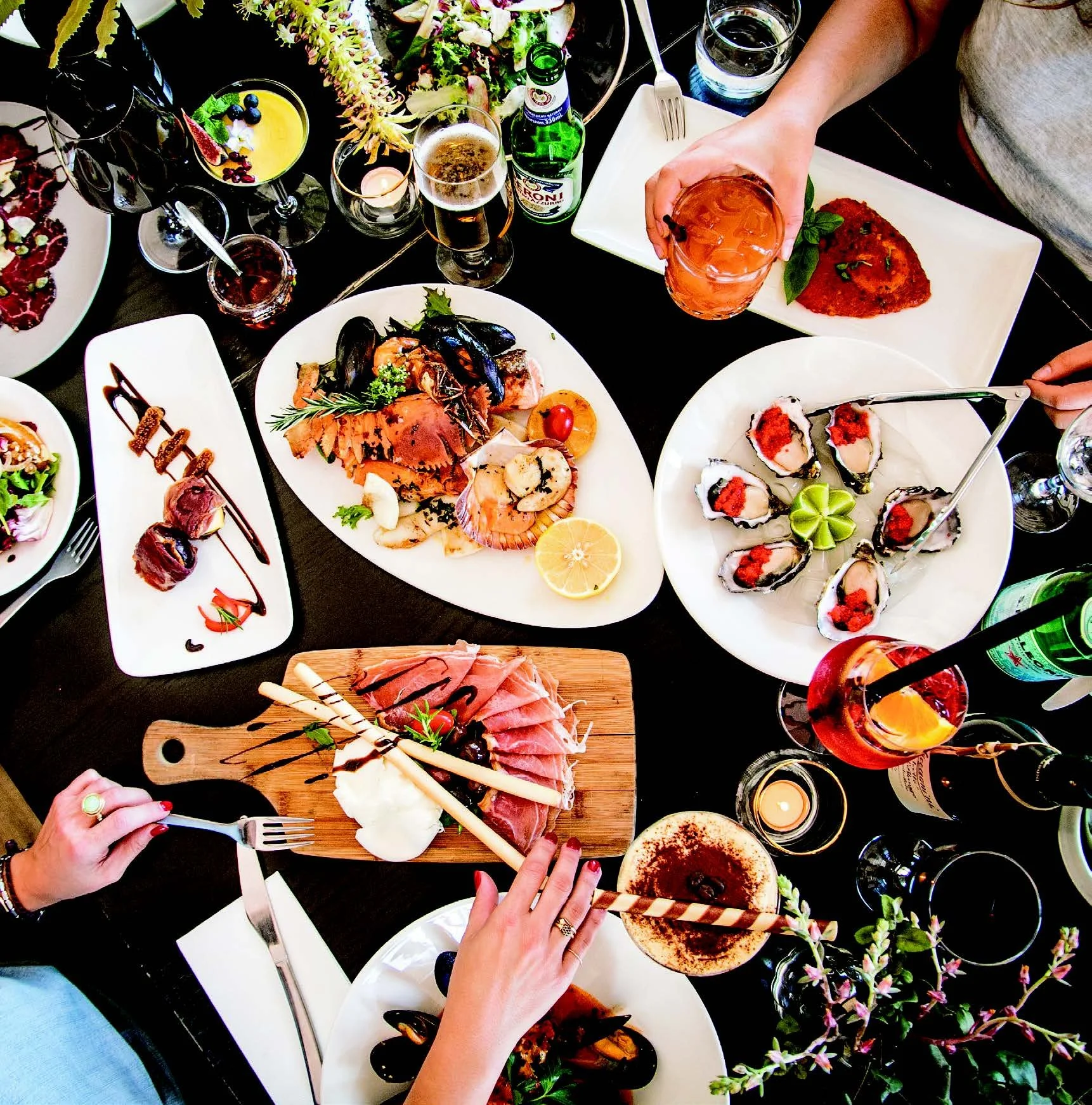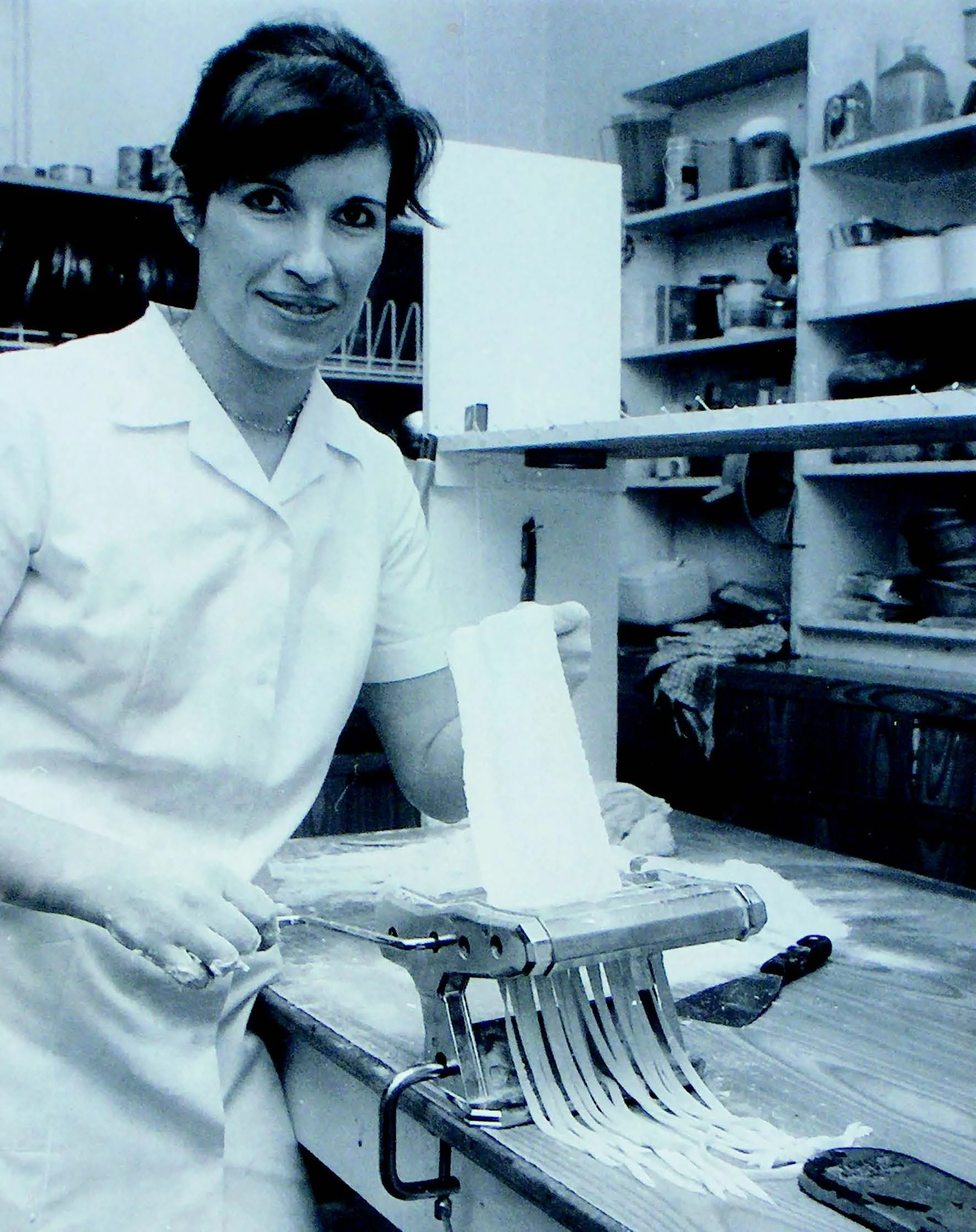FROM CITY TO CITY, GENERATION TO GENERATION
Zia Teresa Restaurant
WORDS BY J’AIME CARDILLO
Italian food and culture migrated to Australia with our grandparents and great grandparents—their passion for cooking traditional food is infectious. Despite its simplicity, Italian cuisine remains at the epicentre of Australian dining.
I spent most of my childhood in my dad’s pizza shop, Charles Street Pizza in Seddon. After school, on the weekends—it was my favourite place. The floors were black-and-white–check linoleum, the tables were set complete with an ashtray and the chairs were burgundy, not leather but the kind of material that you’d stick to regardless of whether it was summer. An archway separated the diners and the oven and led into the milk bar where I’d split a blue heaven milkshake with my dad, most afternoons, before the first wave of orders came through. He’d take a phone order and I’d help myself to the individual lollies behind the counter: red frogs, snakes, milk bottles—anything except the spearmint leaves.
Riding the sugar high, I’d float back through the archway and join my dad behind the counter, grabbing a fistful of fresh dough. I’d flour it and gather the necessities: olives for eyes, shredded salami for hair and capsicums for mouths. I’d set up on a table and mould little dough boys and girls, embellish them with toppings. My dad would slide them into the oven and we’d make pizza boxes as we waited for them to scorch.
Like many Italian migrants in the 1950s, my grandparents brought little more to Melbourne than their culture and infatuation with food. Sunday lunches included everyone’s favourites: the classic penne bolognaise with those marshmallow-like meatballs, the only-for-special-occasions ricotta and silverbeet ravioli which is my dad’s favourite (who is my nonna’s favourite) and of course the very spectacular, very top-secret pillows of potato gnocchi with napoli.
So what is it that makes Italian food so translatable?
At the quieter end of Mount Alexander Road in Ascot Vale is Italy 528. Wrapping the wall is a floor-to-ceiling sepia portrait of the Spanish Steps, instantly transporting you to Rome. Co-owners Rachele Nardella and Antonio Caruso opened their restaurant in 2011 with the hope of staying true to the home country. Rachele says the reason Australia, Melbourne specifically, has embraced Italian food is because Melbourne has an ‘excellent food culture with a high regard for the Mediterranean diet,’ which she says includes a focus on its health benefits.
‘Italian cuisine is popular because of its simple and authentic ingredients.’ Rachele’s ethos translates onto her pizzas, which are fired in the clay oven and topped with minimal ingredients of the highest quality: San Marzano tomatoes, imported porcini mushrooms and Italian black truffle oil. She says the restaurant refuses to get caught up in trends—the dishes remain the same. Instead the focus is on creating homestyle food that is loved.
When I asked for a secret recipe passed down through the generations Rachele pointed me in the direction of the pasta of the day, a traditional orecchiette. The name is taken from their shape—the Italian word orecchia when translated to English means ear. Shaped by hand, orecchiette are traditionally from Puglia—the southern region that forms the heel of Italy’s boot.
Folded away in the residential streets of South Kingsville in Melbourne’s West is Motorino Pizzeria. It’s the kind of restaurant that feels like family—the tables are covered in glossy butcher’s paper inviting children (and me) to draw portraits of our dining partners or to play a game of hangman until there is no more negative space. Murat Kiratlioglu, Motorino’s owner who is of Turkish heritage, says he was drawn to Italian food even as a boy. ‘I can still remember the first time I tasted pizza, the smell of garlic, the taste of mushrooms—some things never leave your memory.’ Working in construction prior to operating a restaurant, Murat recounts visiting Motorino, a business that was already established. ‘The business had a good reputation and a great menu, but mostly it had a homely vibe which is what my family and I enjoy.’ He says the most rewarding part of owning Motorino is seeing family and friends come together to share meals and stories, ‘when I see that, I feel I have achieved what I set out to do as a restaurateur.’
Motorino is one of those word-of-mouth restaurants you know is going to treat you well. From giving children some dough to sculpt—and later serving their creation with chocolate drizzle and ice creamto the quality food at an honest price. Fifty dollars bought my table of two the spaghetti calabrese, a Syracuse pizza with prosciutto, caramelised onion, mozzarella and rocket, and of course a raspberry and lemon curd dessert pizza. Murat says, ‘our success at Motorino comes from good quality ingredients, enjoying what we do which means caring about the little things, being consistent and affordable.’
The Italian restaurant district of Lygon Street occupies a number of blocks between Carlton and Brunswick. The first pizzeria established in Australia was in 1961 and it still sits on Lygon Street, now joined by countless Italian eateries.
Situated at the Brunswick end of Lygon Street is one of Melbourne’s favourite aunties, Zia Teresa—translated from Italian to English zia means aunty. It’s 7.30pm on a Thursday and there’s not a spare chair in sight, which means it’s ‘polpetta night’ at Zia’s. Twenty-five dollars will buy you a glass of wine and a variety of hand moulded meatballs (or veganballs if you prefer).
After migrating to Australia in 1970 Teresa Bruno (pictured) and her late husband worked at Papa Pizza. In 1985 they purchased Papa Pizza and transformed it, opening the doors to Zia Teresa. The idea of handmade quality product was translated into all aspects of the restaurant—the two even built their own tables and hand-crafted new tablecloths.
Teresa—known as Zia to most of Brunswick—says the secret to great cooking is to taste everything while you’re cooking. She doesn’t measure metrically, she measures by heart.
Her daughter and general manager, Linda Jean Bruno, was born into the family restaurant.
‘When you have a generous and honest product that uses fresh ingredients of the highest quality, and provide a service that is personalised you’re not in competition,’ Linda Jean says of trying to maintain success on Lygon Street. ‘We have happily welcomed other eateries into the neighbourhood—we are Italian.’
She says while the area continues to build with versatile eateries and alfresco cafes her mother, who is also the head chef, maintains traditional Italian style—like the gnocchi quattro formaggi and coniglio.
‘We have happily welcomed other eateries into the neighbourhood—we are Italian.’
The dishes that were once new and exotic in Melbourne are now Zia’s specialties. ‘It was one of the first in the area and we still sit in the centre of one of Melbourne’s most popular foodie destinations.’
The menu at Zia’s shows an exploration along the coastal shores of the Mediterranean Sea and extensive travel into the north and south regions: Roman goat, Sicilian veal, Calabrian sausages and the scallopine Vesuvio, dreamt up on a visit to Mount Vesuvius.
‘There may be similar businesses in terms of being an “Italian eatery” but most are specific to a particular region or island—like Sicily. Zia’s inventiveness takes inspiration from all over Italy.’ Linda Jean says her mother borrowed creativity from her own mother, aunties and close friends while she travelled around Italy but that her muse was her late husband: ‘She would cook first and foremost for him.’
Since the day Teresa migrated to Australia her passion and focus has always been to enhance the Italian gastronomic culture in Melbourne. Linda Jean says she thinks the reason Melburnians gravitate toward Italian food is because traditionally it’s not fiddly. It’s simple good food, but there is a skill in delivering that simplicity well.
Zia Teresa Restaurant
MELBOURNE’S BEST SPECIALTY ITALIAN GROCERS
MEDITERRANEAN WHOLESALERS
482 Sydney Road, Brunswick, 3056
A Sydney Road institution and Australia’s largest continental food store, Mediterranean Wholesalers opened as a milk bar in 1941 and began its life as a wholesaler in the 1970s. Stocking pantry staples and specialties from Europe, you’ll find aged prosciutto, bresaola and capocollo, regional cheeses and a comprehensive selection of pastas (we’re talking over 250 varieties).
ENOTECA SILENO
920 Lygon Street, Carlton North, 3054
True to its name, Enoteca Sileno can be translated to a place where wine is collected—a place where wine is the star of the store. The family-owned business opened its doors in 1982 and since then has been importing quality food from Italy. Complete with an on-site restaurant, Enoteca Sileno’s cooking school offers masterclasses in making gnocchi, filled pasta, fresh pasta and sauces, and, of course, pizza.
DOC DELICATESSEN
330 Lygon Street, Carlton, 3053
DOC Delicatessen is home to an array of high-quality, artisan Italian imports. You can buy all of the products that Tony Nicolini and the DOC team have been serving for years, as well as the Australian homegrowns that come highly recommended. The mozzarella bar houses any cheese you can think of (the pecorino is a must!) and don’t forget the cured meats: bresaola, Serrano ham and crowd favourite, San Daniele prosciutto.
LAMANNA SUPERMARKET
10 English Street, Essendon Fields, 3041
LaManna Supermarket started as a fruit shop in West Preston in 1953. Its shape and space have since evolved, now residing in an old hangar at Essendon Airport. It engulfs 10,000 square metres of the freshest products: fruit and vegetables, meat, antipasto, a deli, seafood, its own bakery, juice bar and patisserie (and that’s before the grocery aisles).
BOCCACCIO CELLARS
1030 Burke Road, Balwyn, 3103
Boccaccio Cellars began as suppliers of fresh bread. Most of their customers were migrants from Italy who wanted their bread delivered daily; deliveries quickly progressed to pasta, oil and grappa. Not much has changed over the past fifty years other than Boccaccio becoming one of Australia’s leading wine merchants (they have over 3000 wines).


